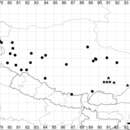Comments
provided by eFloras
In the structure of the fruiting perianth, S. olufsenii approaches the C Asiatic S. corniculata (C.A. Mey.)Bunge. Identification of some specimens from Kashmir is more difficult by their dwarf, delicate habit and smaller size of flowers, fruits and seeds. The identification of Strachey 23 from Pangong remains tentative because of the early developmental stage. By their striking erect habit the individuals approach S. heterophylla which however has never been reported from such high altitudes and a later gathering from the same area (Hartmann 6081) with well developed fruits is typical S. olufsenii. Suaeda olufsenii ascends higher than any other species of the genus.
The taxon requires more field studies and cultivation experiments.
- license
- cc-by-nc-sa-3.0
- copyright
- Missouri Botanical Garden, 4344 Shaw Boulevard, St. Louis, MO, 63110 USA
Description
provided by eFloras
Annual, (2)5-10(15) x 1-10 cm, very variable in habit, prostrate or ascending, rarely erect, primary stem usually equalled by some longer basal laterals, living plants glaucous green, often purplish, dried specimens pale brown; glabrous. Stem much and repeatedly branched from base, only in dwarfed specimens unbranched, at base up to 2 mm thick; when young, with alternating green and pale or purplish lines, later turning straw-coloured, delicately striate, the vegetative part restricted to a few basal nodes; branches erect or ascending, terminating in erect spikes which are often interrupted in lower part and dense in upper part, straight. Leaves few, often very succulent, semi-terete, linear to oblong, (3)5-10(15) x 0.8-1.2(2) mm, subacute to subobtuse, delicately mucronate, with C3 anatomy. Bracts upwards gradually shorter and changing in shape to narrow ovate, higher up to broadly ovate and even almost circular, shortly mucronate, usually longer than glomerules, except for the uppermost. Bracteoles 0.5-0.7 mm long, narrow ovate or obovate, acute or acuminate, the margins in upper part eroso-dentate. Glomerules (1)3-11(15)flowered, axillary, in case of luxuriant growth clusters with up to 30 flowers and the flowers arranged along short bracteate or ebracteate branches that arise in pairs beside the primary axillary flower; with flat base and strongly eccentric hilum, the tepal lobes highly succulent, incurved, much higher than the centre of the flower, cucullate, fused for 1/2-3/4, with 1 tepal much longer and wider and 1-2 somewhat larger than the others; fruiting perianth moderately enlarged, 1.5-2 mm in diameter, outline often irregularly stellate, the lobes along the dorsal line much thickened, in dry condition somewhat keel-like, at the periphery sometimes with up to 0,5 mm long wing-like horizontal outgrowths. Stamens by partial abortion often reduced to 3 or 2, filaments very narrow, band-shaped, 0,3 mm long, inserted at base of tepal lobes; anthers tiny, 0.15-0.2 x 0.2-0.25 mm, divided for c. 1/2. Ovary depressed turnip-shaped; the 2 stigmas inserted at the top of the ovary, 0.1-0.15 mm long, very thin, with short papillae, ascending to spreading. Seeds horizontal, more rarely oblique, 0.9-1.1 mm long, 0.75-0.8 mm high, 0.45-0.5 mm thick, strongly flattened, beak short, incurved; testa chestnut-coloured, dull to somewhat shining, distinctly sculptured.
- license
- cc-by-nc-sa-3.0
- copyright
- Missouri Botanical Garden, 4344 Shaw Boulevard, St. Louis, MO, 63110 USA
Distribution
provided by eFloras
Distribution: From the Pamir in E Tadzhikistan and NE Afghanistan through the Karakorum and the Tibetean plateau at least reaching close to Lhasa and to the Kuenlun, further north in the Alai Mts. and the E Tien Shan of Kirgystan.
Central Asiatic, alpine.
- license
- cc-by-nc-sa-3.0
- copyright
- Missouri Botanical Garden, 4344 Shaw Boulevard, St. Louis, MO, 63110 USA
Habitat
provided by eFloras
Salt-marshes around permanent or temporary lakes and in depressions with saline soils in the alpine semi-desert zone from about 3500-4800 m, there sometimes as the only higher plant.
Central Asiatic alpine, extending into the Siberian Arctic.
- license
- cc-by-nc-sa-3.0
- copyright
- Missouri Botanical Garden, 4344 Shaw Boulevard, St. Louis, MO, 63110 USA
Synonym
provided by eFloras
S. corniculata var. olufsenii (Paulsen) Kung & Chu in Fl. Reip. Pop. Sin. 25,2: 128. 1979; S. corniculata sensu Hook.f., Fl. Brit. Ind. 5: 14. 1885; R.R. Stewart, Fl. Ladak 631. 1917; Ann. Cat. Vasc. Pl. W. Pak. Kashm. 227. 1972; Li in Fl. Xizang. 1: 642. 1983; S. microsperma sensu Hook.f., Fl. Brit. Ind. 5: 14. 1885; R.R. Stewart, Fl. Ladak 631. 1917; Pampanini, Fl. Caracorum 102. 1930.
- license
- cc-by-nc-sa-3.0
- copyright
- Missouri Botanical Garden, 4344 Shaw Boulevard, St. Louis, MO, 63110 USA
Description
provided by Phytokeys
Annual up to 25 cm, glabrous or young parts are slightly pubescent with curved hairs, branched from the base with prostrate stems. Leaves up to 15.0 × 2.0–4.0 mm, semi-terete without or with an inconspicuous mucro. Inflorescence bracteous. Bracts rather flat, ovoid or elliptical. Flowers 3–12 in clusters. Perianth at fruiting stage with unequal horizontal wing-like projections (Fig. 39D). Stigmas 2. Seeds dimorphic: dark-red seeds 0.9–1.0 mm in diameter, marginally acutish, surface with remarkable polygonal sculpture (Fig. 39E, F), brown seeds 1.1–1.5 mm, with rugose surface.
- license
- cc-by-3.0
- copyright
- Alexander P. Sukhorukov, Pei-Liang Liu, Maria Kushunina
- bibliographic citation
- Sukhorukov A, Liu P, Kushunina M (2019) Taxonomic revision of Chenopodiaceae in Himalaya and Tibet PhytoKeys (116): 1–141
- author
- Alexander P. Sukhorukov
- author
- Pei-Liang Liu
- author
- Maria Kushunina

